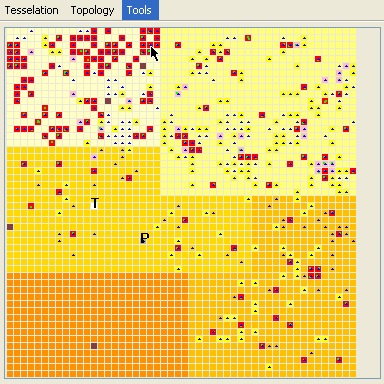|
SimDrug
Exploring the complexity of the heroin drug use in Melbourne (Australia)
A. Dray and P. Perez
Background
SimDrug is a multi-agent system model, built with Cormas, as part of
the Drug
Policy Modeling Project, led by Turning Point, a specialist alcohol
and drug organization based in Melbourne. The project aims at addressing
a demand for new integrative approaches to support policy makers and practitioners
who implement illicit drug policy in Australia.
SimDrug focuses on the representation of dynamic relationships between
law enforcement, treatment, harm reduction and prevention. Its design
is based upon a real case-study: the heroin 'drought' that struck the
illicit drug market in Melbourne in 2000. The supply of heroin in Melbourne
suffered a dramatic decline between late 2000 and early 2001, after a
strong increase in heroin use and related harms in the late 1990s. This
change in heroin supply led to a substantial decrease in overdoses. Field
experts argue that the drought was actually shadowed by a dramatic increase
in psycho stimulants, resulting in a fairly constant number of injecting
drug. On the other hand, the heroin drought is held up by the Australian
Government as an example of law enforcement (seizure, syndicates dismantlement)
having a significant impact on the supply of drugs.
Model description
 Time
scale Time
scale
One time step is equivalent to a 24h-day in reality as injecting behaviors
need accurate time scale. Each simulation is run over a 5-year period
(1998 - 2002 dataset) to allow the model to be able to consistently reproduce
pre-drought, crisis, and post-drought dynamics of the system.
Spatial environment
SimDrug works on an archetypal representation of Melbourne based on a
regular 50*50 square mesh, each cell representing a street block. Five
suburbs (defined as an aggregation of neighboring cells) are created with
different sizes and shapes, regardless of realistic features. Two special
cells represent the Police Station and the Treatment Center.
Social entities
SimDrug includes different types of social agents: 3000 users, 150 dealers,
10 wholesalers, 10 constables, and 10 outreach workers. Figures are based
on a 1:10 scale of the reality.
Model dynamics
Each time step encompasses the following stages:
- The population of agents, based on the changes triggered during the
previous time step is updated. All detainees are retrieved from the
system and new users, dealers and wholesalers are created accordingly.
- Wholesalers and dealers interact towards drug supply. Wholesalers
are given the opportunity to refill their supply once a month while
dealers can visit their wholesaler as soon as their drug stock is sold
out.
- Outreach workers interact with users in order to decrease their readiness
for treatment and convince them to enter into treatment.
- Users interact with their environment and other agents. They start
by assessing their need looking at their available cash and drug and
decide whether they need to commit a crime. They, then, find their usual
dealer (or alternatively a new dealer) and buy some drug. They use it
at once and might declare an overdose.
- The Treatment Center manages new users entering treatments and on-going
treated users reaching the end of their treatment duration.
- Street blocks risk and conductivity are updated and the new suburbs'
protest values are calculated accordingly.
- The police station adapts its strategy by reallocating constables
on the grid and eventually performing successful crackdowns.
Model code and documentation
The Cormas model -including the smalltalk code, a set of UML diagrams
and a description of the variables- is available here.
Reference
Perez, P. and Dray, A. 2005. Monograph No. 11: SimDrug: Exploring the
complexity of heroin use in Melbourne. DPMP Monograph Series. Fitzroy:
Turning Point Alcohol and Drug Centre. 
For more information, contact the
corresponding author
|

